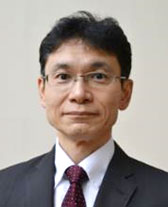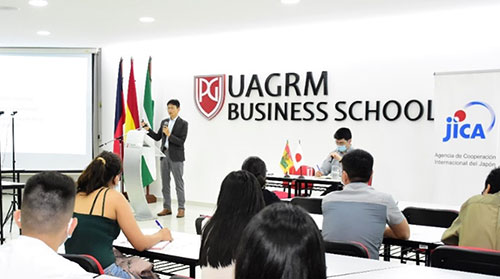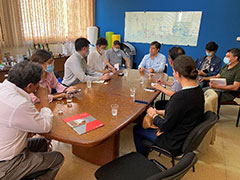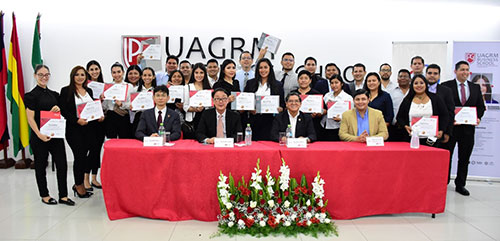April 16, 2023
Gaku Funabashi (International University of Japan/JICA)

So far, as a JICA Chair, my activities have largely focused on one-off seminars. Among these, there is a country with which we have had a specially lasting and fruitful relationship—Bolivia. I remember it started in December 2021, and this relationship continues until today. In fact, I recently delivered a lecture in March 2023. This time, I would like to share my own thoughts on what it means to be a JICA Chair, specifically with respect to my experiences in Bolivia.
I was involved with the Autonomous University of Gabriel Rene Moreno (UAGRM) Business School in Santa Cruz. The reason the JICA Chair with UAGRM continues is that it incorporates a diploma course for companies that is held over several months and is named "Corporate management based on the Japanese model." Although no degree is awarded at the end of it, it is recognized as a university program.
The course, which consists of five modules, mainly focuses on Total Quality Management (TQM), and the latter three modules of the course are used to promote the understanding and practice of quality management by local companies. Japanese-style TQM is a methodology that was originally introduced to Japan from the United States as a scientific management method and has evolved over the decades after World War II to suit Japanese companies. In order to understand the background of why it came to be this way, the contents of the first two modules are set so that one can also learn about Japanese culture and the development of Japanese industry.

Lecture at Autonomous University of Gabriel Rene Moreno (UAGRM)
In order to judge the appropriateness of the course content, it is important to examine how the perceptions of the course participants have changed and the scenarios in which these changes can be applied in the company. In July 2022, I had the opportunity to go on a business trip there and I asked the business school to arrange a company visit. We were able to visit eight diverse companies ranging from micro enterprises to large enterprises, in sectors ranging from manufacturing to service industries.
Usually, when we request a company visit to verify the effectiveness of a JICA project, we are introduced to a company that is doing relatively well. As a result, generally positive results are often obtained. Although Bolivia was no exception to these expectations, there was still a clear difference compared to other countries—at almost all the companies we visited, the participant human resources had a specific awareness of the various issues for which they had to consider countermeasures before they participated.
This sounds obvious. However, in fact, there are surprisingly few people who clarify such issues before they participate in the training. There is a major difference between participating in a course with a vague idea of what one would learn and participating in a course with total clarity on a problem to solve, in terms of the learner’s sensitivity. If their sensitivity is high, then that increases the possibility of them being able to recognize that it can be used to solve the problem one encounters during participation. This leads to immediate adoption into practice. Other countries are not without such participants, but it was a bit surprising that the percentage of participants with such tendencies among the companies we visited in Bolivia was remarkably high.

Visiting a wine manufacturing company

Exhibition of products from small-to-medium size companies
It is also worth noting that several people said that the module on Japan, which was designed to help them understand the background of TQM, was better than expected. One participant said, "With the explanation of the cultural background, I was able to understand what kind of background makes the tools easier to use. It is important to know what is necessary to promote understanding even in different environments." At the same time, it contains important suggestions for the JICA Chair.
It is true that behind the many Japanese companies that have been able to practice TQM, some employment practices are highly specific to Japan. However, there is no point in implementing a JICA Chair if the general opinion is that it is impossible in another country. The fact that the Bolivian companies were able to put it into practice, instead of stalling at that point, was largely due to the inclusion, in the course, of content that allowed cultural differences to be recognized and acknowledged. Recognizing the difference makes it easier to think of alternative drivers that could be used in practice. One of the reasons they kept thinking about it was that they had a strong awareness of the above-mentioned problem, "I want to solve this problem." What can be done at the preparatory stage to meet these two requirements—a clear recognition of issues and a search for drivers for practices that suit one's own country?
In addition, as a third point of view, I would like to touch upon the instructor's stance. When I talk about Japanese-style management, I first present the entire theory of management strategy, including the findings of research done by Western scientists. After explaining the differences between several schools, I then mention the affinity between the resource-based view of management theory—which is one of the schools—and Japanese-style management. In the past, there was a time when the peculiarity of management practices adopted by Japanese companies was simply justified with the phrase, "Japan is different." However, this does not mean that Japanese-style management is special and different from that in Europe and the United States; it simply shows the position of Japanese-style management within the theory as a whole. With this background, we will examine how the essence of the management theory, such as internal management resources as a source of competitiveness, especially intangible assets, has been accumulated through corporate behavior and the exchange of information between people in Japan. This is shown using examples from companies. At the same time, I also talk about situations in which the Japanese-style management approach makes little contribution. This is why I intentionally include the perspective that some companies did not significantly benefit from Japanese-style management and thus lacked international competitiveness. Rather than simply admiring what Japan has done, it is necessary to objectively explain both the positive and negative aspects in order to gain the understanding of people from other countries.

A commemorative photo taken with graduates at the graduation ceremony for the first diploma course